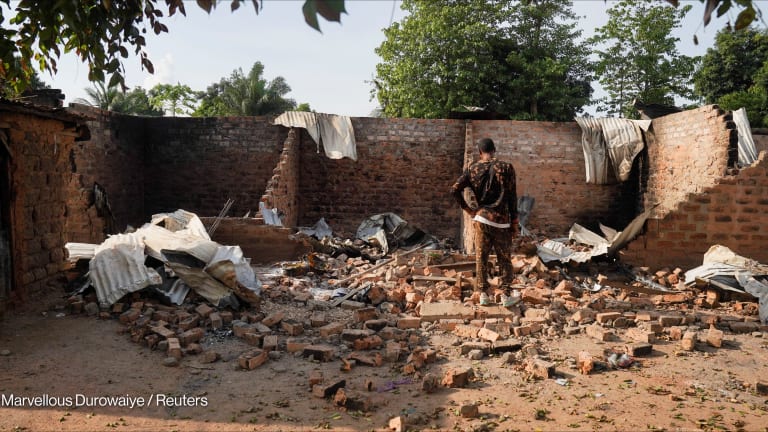
JUBA, South Sudan — It’s been seven months since South Sudan signed a fragile peace deal in an attempt to end the country’s crippling five-year civil war, but the international community is growing increasingly skeptical that this agreement will be any different from the failed attempt of 2015.
In less than one month, opposition leader Riek Machar is expected to return to the capital to once again serve as President Salva Kiir’s deputy. Yet crucial security arrangements are still not in place, while the rest of the deal’s implementation has been rife with delays, missed deadlines, and continued fighting in parts of the country. Last month, the International Crisis Group warned of the deal’s “high risk” of collapse.
“What you’re facing now is trying to create a peaceful, stable country, while at the same time creating governance within. That’s a momentous task.”
— Sophie Stecher, former senior analyst, U.N. peacekeeping mission in South SudanWhile the government and opposition struggle to piece the country together, aid groups are trying not to repeat mistakes from 2015.
Devex caught up with four seasoned humanitarians working in South Sudan when both deals were signed to learn what humanitarian response approaches are effective on a road toward peace — and what they hope is done differently this time.
Understand the context
“We need to respond to the context as it is, not as we wish it was,” said Elizabeth White, head of analysis and outreach for the Conflict Sensitivity Resource Facility and previous policy and campaigns manager at Oxfam.
Under a shaky peace deal, is it too soon to invest in South Sudan's development?
Four months after South Sudan's warring parties signed a fragile peace deal, Devex asked some of the country's major humanitarian players when to expect a shift from emergency response to development.
After the 2015 agreement, there was an appetite to shift toward resilience and a development focused response, which would have made sense in terms of what a peace deal “should” have delivered, said White, who has worked in the country for almost four years. But in reality, it wasn’t the primary need on the ground at the time.
The same pattern is now repeating itself where the response isn’t based on the needs, but rather the circumstances, she said. For example, funding reductions and a sense of “exasperation” of pouring money into life-saving assistance with no long-term impact is pushing organizations to shift focus from humanitarian aid, White said.
It’s important for aid groups to contextualize their understanding of resilience by designing aid in a way that encourages positive interactions and mutual co-dependency within and between communities, addressing both the emergency needs while fostering longer-term planning, she told Devex.
But conflict mitigation specialist Chris Wulliman, who has been working in South Sudan for more than six years, said aid workers need to realize they’re fighting a “losing battle” when it comes to designing plans for peace.
“We failed to acknowledge the reality that peace is elusive in South Sudan and conflict has been a way of life for this country,” he said of the 2015 peace deal. “It will likely always be bound up in one conflict or another.”
Four years ago, aid groups believed the government wanted peace and would do the right thing for its people, he said. But that mentality was flawed and as a result, there was no long-term plan to deal with a country prepared to be at war for a very long time.
One thing that would help the international community better adapt to the context is if donor countries committed to having their staff in South Sudan longer term, he said. Right now most contracts are a minimum of a year with the majority of people staying for a maximum of two years.
“South Sudan cannot be built by a large number of international humanitarian organizations.”
— Chris Wulliman, conflict mitigation specialistSouth Sudan would benefit from people who stay three to four years, gaining knowledge and building institutional memory, and thus able to develop a deep understanding of the operational, political, and security programmatic environment, and be able to respond accordingly as the context changes, he said.
Build capacity
After the Comprehensive Peace Agreement was signed in 2005, which launched southern Sudan into independence from the north, former senior analyst at the U.N. peacekeeping mission, Sophie Stecher, recalls the immense gaps in terms of trying to stabilize the country. Those disconnects still haven’t been addressed today, she said.
“What you’re facing now is trying to create a peaceful, stable country, while at the same time creating governance within. That’s a momentous task,” she said.
Stecher worries that South Sudan is heading into a period where it will need assistance, but that the government might not always ask for help or be willing to accept it. Both the international community and the government need to come up with common parameters for how to address this disconnect.
“There have to be very upfront discussions on how it can be managed and what can be offered in terms of assistance,” she said.
Another longtime aid worker who wasn’t authorized to speak on the record agreed that the government needs support with capacity building, training, and establishing systems for public administration that are accountable, transparent, and based on best practices.
The aid community can help the government to better manage its resources and provision of services without creating dependency, they said. In 2015, there was little support provided toward institutional change and the government was under no obligation to bear responsibility for the fate of the country, they added.
For Wulliman, the key lies in local organizations, which need to take over more of the relief and development projects allowing international groups to reduce their presence, he said.
“South Sudan cannot be built by a large number of international humanitarian organizations,” he said. It’s important for the international community to invest in existing civil society organizations and national NGOs that are doing good work.
Avoid reinforcing drivers of conflict
In countries with protracted fighting such as South Sudan, there are people with vested interests in perpetuating systems that can drive conflict, White said. In 2015, the international community inadvertently “entrenched the status quo,” and White warned that this time around donors and aid groups need to do what they can to avoid feeding these systems and look for ways to drive alternatives forward.
This means being conscious of which groups to engage with when delivering aid so donors and international organizations aren’t reinforcing harmful power dynamics between communities and authorities, she said. “[It’s] understanding the context we’re operating in and how aid interacts with it.”
Another thing organizations can do this time while they wait and see how things will unfold, is to learn how to walk away from communities that aren’t ready for peace, Wulliman said.
“Oftentimes we were faced with situations wherein the objectives were unachievable or wherein unrealistic demands were being made and the program tried to carry on only to have wasted time and money on these efforts,” he said.
If there’s no willingness of the communities to engage on a project or when authorities or communities’ demands exceed what is appropriate for the program, it’s better not to insist.
But ultimately, for progress to be made toward peace, the power remains in the hands of the government and the opposition. International pressure won’t make a difference if people are unwilling to change, he said.








